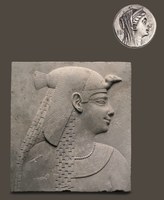Introduction
When the Greeks Rules Egypt
Soon after the conquest of Egypt in 332 BCE, Alexander the Great marched east in pursuit of Darius III. At Alexander’s death it was his Macedonian general, Ptolemaios son of Lagos, who became Egypt’s governor and subsequently self-proclaimed king. He proceeded to create a kingdom that, at its apogee, controlled not only Egypt but also vast areas of modern-day Libya, Israel, Jordan, Lebanon, Syria, and Cyprus, as well as the entire southern coast of Asia Minor. Military conquests, successful economic reforms, and the effective exploitation of natural resources brought about a luxurious wealth that favored the development of the arts. The kingdom would eventually fall in 30 BCE with the arrival of Octavian and his troops, followed by the suicide of Cleopatra VII and the incorporation of Egypt as a new province in the expanding Roman Empire.

When the Greeks Ruled Egypt: From Alexander the Great to Cleopatra, presents an innovative view of Egypt’s dynamic Ptolemaic rulers and how this royal house cannily manipulated long-standing Greek and Egyptian traditions, as well as family ties, in order to maintain power and inspire loyalty among the conquered population. Comprising royal portraiture, coinage, religious and funerary objects, and writings on papyrus, ISAW’s exhibition provides a comprehensive view of cultural hybridism during the Hellenistic period.
The exhibition begins with royal portraiture, which was thoroughly exploited by Alexander’s successors to legitimize their claims over the vast empire. For the Ptolemies sculptural depictions of the royal family, strategically placed in both religious and civic settings, became an integral part of their propaganda meant to reach the widest possible audience. Depending on the intent of the portraits, they depicted the king or his spouse in traditional pharaonic guise, Hellenistic style, or a hybrid of the two. As this royal house was rife with political and familial intrigue, Ptolemaic portraiture also reveals the role of familial intermarriage and its political implications.
Alexander himself took pains to show respect for the Egyptian gods upon entering Egypt, and the Ptolemies, with great political skill, continued to embrace the majority of existing religious traditions. When the Greeks Ruled Egypt looks at the Ptolemies’ strategic reinterpretation of Egyptian divinities, with a focus on the trinity Osiris, Isis, and Horus. This triad was a particularly apt choice of deities, through which the Ptolemies positioned themselves as divine: indeed, Osiris and Isis were brother and sister who married, while Horus was their offspring. The promotion of the trinity, therefore, was a means of legitimizing intermarriage practices, especially for Greek audiences that had never been exposed to such customs.
The exhibition next moves to a section devoted to funerary traditions, focusing on the coexistence of a variety of customs during Ptolemaic rule—when Egypt was a hub of international activity, with foreign groups from both the Mediterranean and Ancient Near Eastern worlds living in the same communities. The presentation in our galleries juxtaposes Greek and Egyptian funerary monuments that were often found side by side in the main Ptolemaic necropoleis.
Finally, a series of manuscripts on papyrus demonstrates the variety of languages spoken in Egypt both before and during Ptolemaic rule, brings the focus from the political to the personal, and opens a window onto various concerns of daily life. Highlights include a group of fifth-century-BCE papyri drawn from the archive of Ananiah and his wife, Tamet, that illuminate the complex social and cultural dynamics of the Jewish garrison of Elephantine, where Aramaic was spoken.
The wide array of ancient objects and documents on display elucidates the complexity and sophistication of Ptolemaic Egypt, an era in Egyptian history during which innovations brought about by Hellenized rulers were effectively fused with age-old pharaonic traditions.